Northland, New Zealand.

Lochmarin
Thu 18 Dec 2014 05:45
35:18.63S 174:7.777E  Hokianga, Northland, massive sand dunes (for riding down on body boards!) on the left. We didn’t manage to lift the boat onto the hard. We arrived back in time to finalise things with the yard, but then they realised that although they’d be able to lift Lochmarin out of the water, they’d not be able to put her down out of the travel lift. We could reverse her into the slip, with our wind turbine passing underneath the beam across the top of the travel lift, then get lifted up out of the water before being trundled off to the yard. However, once she was lowered into the cradle in the yard, the wind turbine on her stern wouldn’t clear the back of the travel lift - being in the cradle is higher than being down on the water. Oh well, back to the drawing board! In the mean time something wondrous had happened: we’d bought a car! As we’ll be here for most of the cyclone season we figured it was sensible to buy one and sell it when we leave. It’s a real pleasure to have a car again after 2 1/2 years. Of course there's the convenience of being able to ‘pop’ to places: run out of gas? Just ‘pop’ to the garage and re-fill the tank, instead of having to make an intrepid voyage for half an hour in the dinghy, brave the surf on the beach then have Phil carry the tank up the road whilst I stand guard on the dinghy (being eaten alive by sand flies of course). But apart from that it’s lovely just luxuriating in driving: looking at the fantastic scenery, listening to our favourite tunes on the iPod, enjoying each other’s company as we explore. So explore we did, we borrowed a tent from my sister, packed up the car and took off. 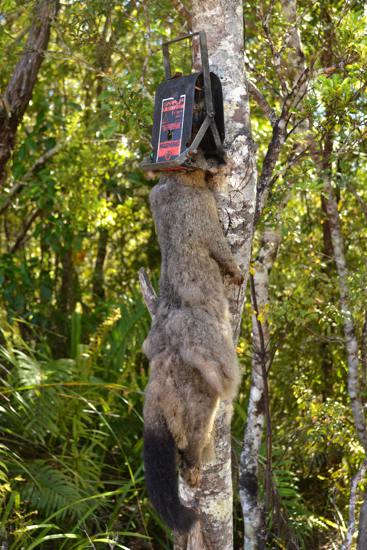 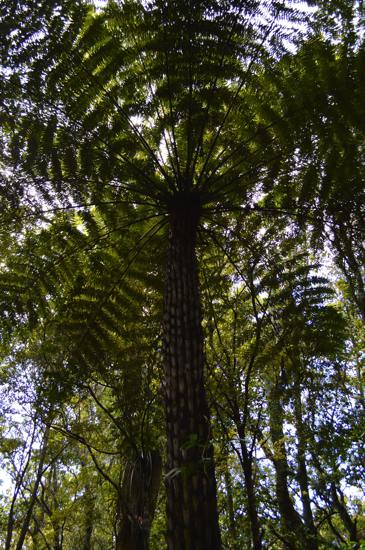 A possum who fell foul of a trap and looking up through the branches of a Tree Fern (Ponga tree) in the bush (bush means forest or woodland here!). Our first few nights camping we needed them. The wind howled all night and the rain lashed down, the sides of the tent shuddering under the blasts. We daren’t go out for a wee as I’m sure it was the weight of our bodies that was stopping the whole thing from bowling off across the camping field. But by morning the wind had dropped and the rain ceased and we were woken by the laughter of kookaburras, the song of the tui: sparkling dew drops of sound, interspersed with snorts, clucks and Marimba bongs (https://www.dropbox.com/s/4kn035w8ah6a5e5/Tui%20Copy.m4a?dl=0), and by the blackbird’s morning salute of the new day. New Zealand has such a mixture of bird life: the kookaburras are stowaways from Australia, the Tui a native here, the blackbird, along with sparrows and thrushes and chaffinches, were imported in the 1860s to make the exiled Brits feel more at home.  90 Mile Beach, brilliant for land yachts. Not actually 90 miles, only 55 miles, but a bloody long beach anyway! We had discovered the delights of New Zealand coffee shops almost as soon as we got ashore, they take their flat whites pretty seriously here you know, so after a rather chilly night camping alongside 90 Mile Beach we decided to break camp early and go find a coffee shop for breakfast. Little did we know that coffee shops hadn’t migrated that far North. We searched in vain, driving for hours, to find one. If we’d wanted bait, fresh or frozen, salt ice or regular ice, we could have had them by the bucket full. There were plenty of Four Squares (like Spars in the UK) but a coffee shop wasn’t to be found. We had to cross to the Eastern side and drive down two bays to Mangonui before we got far enough South to be back in the world of craft shops and decent coffee. Civilisation at last! We quickly found out that the best campsites were DOC (Department of Conservation) ones. They varied from quite luxurious, with bins and hot showers, to absolutely basic (and absolutely free) with just river water and a long drop. Our favourite was in Puketi Forest: £3 a person a night but for that you get a water tap, cold showers, long drops and as much ready chopped wood to burn as you need! The long drop compost loos were fine; they didn’t smell bad but they were a bit tickley. You see when you sit down the flies all head for the day light and come up from between your legs. An advantage of this was that a Fan Tail (a wonderful local bird, very friendly) would fly in under the eves to join you in order to eat the flies. Good company when one is contemplating. 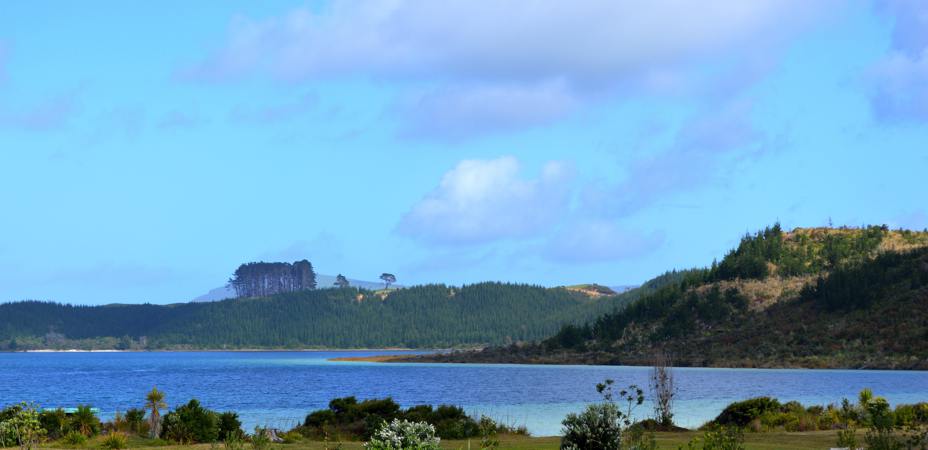 Kai Iwi Lakes, view from our tent, one of the DOC campsites. You know all about New Zealand scenery of course, and if you don’t just take yourself off to some self respecting cinema and watch The Lord of The Rings. They took much better pictures than I could have. Northland is superb, rather like Scotland we thought. Rolling hills in the foreground with layer on layer of blue forested mountains beyond. In between are floodplains with huge meandering brown rivers lazily making their way to the seas, fed by tumbling streams with picture post card bridges over them so the farmers can get to the green fields where cows graze. The cows seem to be very well trained. We often see them ambling purposefully along the sides of hills in a long line, clearly taking themselves off to be milked. A rather strange feature of the dairy farming here is that they seem to keep lots and lots of cows in one small field, even though there are plenty of empty fields around them. In the UK I’m sure the cow density is lower. One disconcerting feature of the farming up here in Northland is a thing called 'Home Kill'. We saw signs advertising it and spent many days discussing quite what it meant before finding out the truth. We were sure it wasn’t what the Americans seem to suffer so badly from, with their excess of guns: we felt certain it had to do with animals not people or they wouldn’t advertise it. But what exactly was going on? Did they sell you a cow or a pig to take back home to kill? A clue appeared in the form of a ‘ute’ (pickup) we were driving behind. In the flatbed were four bits of cow. Big bits. In fact they appeared to be four whole legs and haunches, still with hair on, and with what looked like brown paper over what would have been the bloody bits. It was a forlorn hoof sticking up, gently waving at us with every bump in the road, that alerted us to the contents. No refrigerated lorry, no dust cover, just being driven down the gravel roads in the blazing sunshine… A butcher put us out of our misery and explained. Farmers can kill their own stock on their farms to feed themselves, their family and their workers. Maoris can also kill stock for celebration feasts. When they’ve killed the beast and chopped it up into big pieces they can take the ‘Home Kill’ to a butcher and get him to take the hide off and convert it into nice cuts to give back to them, but he can’t sell it to the general public. However, if you ask me, they take it a bit far here in Northland. We were driving back from Auckland to Opua in the dark one evening and, in a lay by at the side of the road, a man had stopped his van, opened the back doors wide and hung a cow from them, a hoof tied to the top corner of each door. On the ground under the cow were piles of innards and he appeared to be hacking at the cow with an axe: big two handed overhead chops. All this was lit up by floodlights on the back of the van. We didn’t feel like stopping for a break in that lay by. 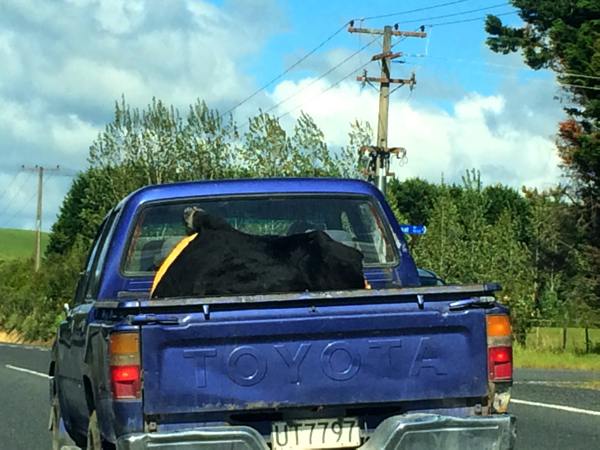 Bits of Home Kill… see the hoof tapping on the back window? Happily the bad weather didn’t last. It's spring here, of course, and you know how you can get a few days that lull you into a false sense of security, when you think summer's arrived? Well that's what happened here; shorts and t-shirts got pulled out of the cupboards, white white legs and red red necks appeared all over the place and particularly just up the estuary from us in a little town called Paihia. It's a real seaside holiday town, just lacking the kiss-me-quick hats. Wonderful for people watching. Like most places in the world, kiwis are a real mix, with trendy modern fashionable folks rubbing shoulders with the, well, shall we say "left behind' folk. Paihia seems to have more of it's fair share of people stuck in a seventies time warp as far as fashion is concerned. Nothing wrong with the seventies of course: long collars, wedge heels, lots of denim, interesting colour combinations. But it does tend to draw the eye in this day and age. It doesn't look as if people are going retro, you understand, it just looks as though they haven't bought any new clothing since then. 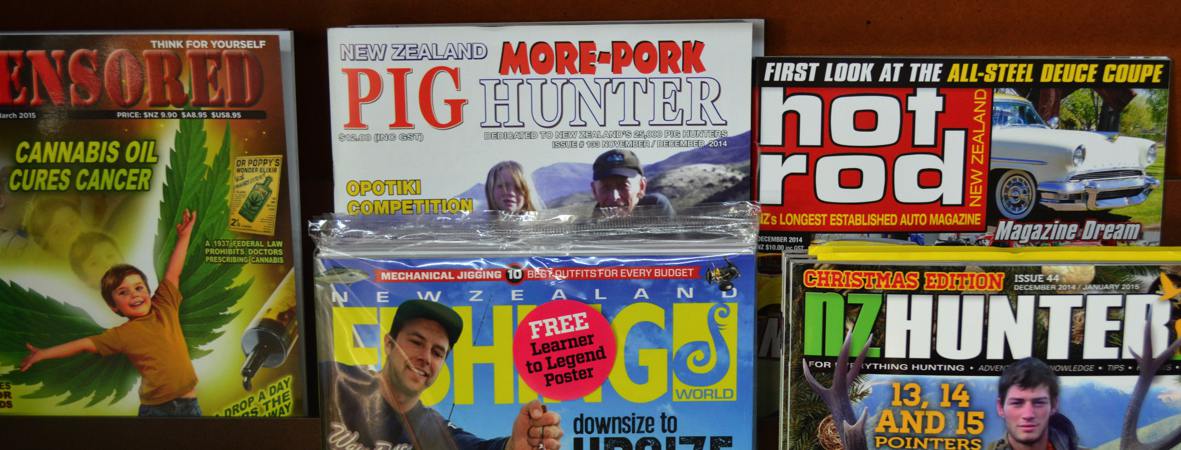 Typical Northland reading matter, taken in Opua General Store. |